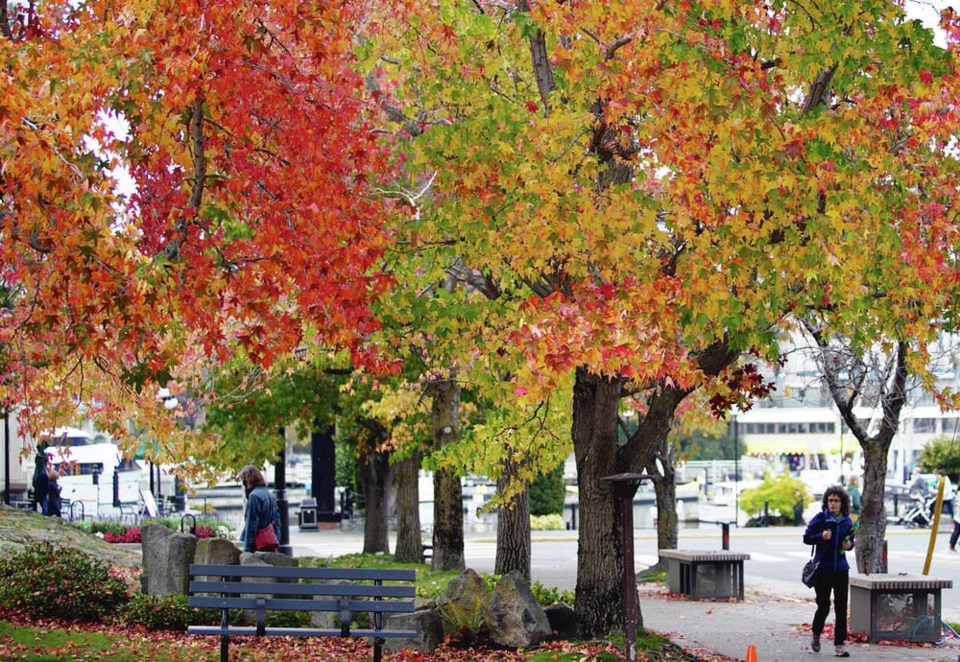The maples are turning gold and red, the Garry oaks are going brown, and the grass is springing fresh and green anew.
But the change of seasons brings more than a changing landscape palette to dazzle our senses. The scentscape also changes with the turn of the year.
Smell happens when the chemical receptors in your nose detect scent molecules in the air. Plants release these volatile compounds through their leaves, needles, flowers and bark, and critters release them through their breath, skin and scent glands. Objects also emit, exhaust, or off-gas them.
The smell of air depends on the type and concentration of these volatile compounds in the air that you breathe in and that trigger the scent receptors in your nose.
Come fall, the compounds some scent-producers emit change. Plants go dormant and drop their leaves, which start to decay, releasing different scent compounds than the growing plant did. Few blossoms unfold in fall to perfume the air.
Our own activities contribute to the shifting scentscape. On summer evenings, the smell of burning fat and caramelizing protein from backyard barbecues wafts through neighbourhoods. Come fall, woodsmoke from fireplaces and wood-burning stoves perfumes city evenings.
We sweat more in the summer heat, leading to opportunities for smelly chemistry thanks to sweat-loving bacteria in our clothing and on our skin. Come cooler weather, the BO issue tends to be contained in the gym, locker and laundry rooms.
Weather itself also affects the physics of the scentscape and the biology of how we perceive it. Cooler fall temperatures slow the movement of molecules in the air and cause them to take up less space. This leaves less space for odour molecules to move through the air. As a result, many odours that sing or shout for attention in the summer merely whisper in cool weather.
The south Island’s humidity during the cooler months can intensify some fall scents. Humid air, provided it isn’t too cold, holds odour molecules longer and boosts our own olfactory abilities.
This combination allows the scents of cedar boughs, rotting leaves, and earth, for example, to stand out.
In late summer and early fall, the ground smells baked, and dried grass, leaves and needles smell sun roasted. Every rain shower releases a hit of fresh scent called petrichor.
Coined by Australian researchers in the 1960s, the word comes from the Greek words petra, for stone, and ichor, for the blood of mythological gods. Who says you can’t get blood (of a sort) from stone?
Petrichor consists of varying combinations of fragrant chemical compounds in the local environment. Some are essential oils made by plants. Some are molecules left by passing animals that left their own scent markings.
The compounds could include anything we poured onto the ground — paint, oil, old bathwater, and so on. The main contributors, however, tend to be bacteria that break down decaying organic matter. As these bacteria go about their decomposing business, they generate an alcohol called geosmin. The human nose is able to detect just a few parts of geosmin out of a trillion air molecules.
When rain hits dry ground, it percolates down into the many microscopic cracks, crevices and pockets. As it soaks in, it displaces those volatile compounds, causing them bubble up to the surface as a kind of champagne fizz. When the bubbles hit the air, they just keep going, up and up, catching a breeze to waft away or a nose to trigger a scent sensation.
The aerosol-fizz event happens only when the ground is permeable and only during light and medium rain. Impermeable ground permits neither the absorption of volatile chemicals nor the required percolation of rain that would displace them, while heavy rain drowns the process.
With October showers, petrichor is part of the fall scentscape. But here on the wet coast, the Pineapple Expresses heading our way will wash out petrichor.
Afterwards, local scents will re-emerge, bringing whiffs of winter mould and mildew of west coast vegetation, the cool spice of evergreens, the salt–iodine of the nearby ocean, and whatever woodsmoke, exhaust and other pollution we add to the mix.
keiran_monique@rocketmail.com



